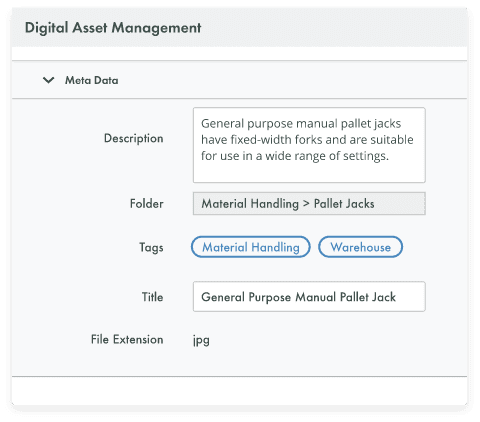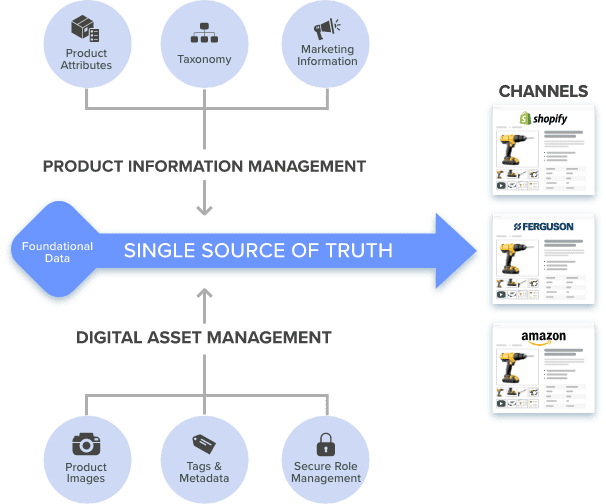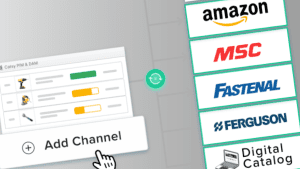A Deep Dive into Digital Asset Management (DAM) Metadata

- Metadata is crucial for effective digital asset management, enabling searchability, organization, and collaboration.
- Industrial brands need metadata management to handle complex assets, comply with regulations, and facilitate cross-team collaboration.
- Best practices for metadata management include strategy development, choosing the right DAM, user training, and regular governance.
In this Article
Let’s face it: file management is a challenge. It’s worse when you have thousands of assets and no system to structure and organize them. Someone recently posted a rant on Reddit about just how severe a headache managing files was getting.
According to the original poster (OP), they have about five hundred thousand image assets and two hundred thousand audio/music assets. The issue is that they must continually organize files and restructure folders, which gets to their nerves. To make matters worse, the OP cannot quickly find the stuff they need when searching through the assets.
“It sounds like you need a DAM solution,” one commenter replied. Another commenter added that while getting a DAM solution is a crucial first step, introducing a structure allowing quick and efficient searches is the most challenging step. The term “DAM metadata” also emerged as the best solution to manage unstructured data.
To some, this discussion may come across as esoteric. To others, such as the OP, things like DAM and metadata might not seem too strange or technical, but they don’t know how to leverage them to make it easy to manage files. You are at the right place if any of these two scenarios sound familiar. Just read to the end and see if things clear up.

Understanding Metadata: Basics and Definitions
What is metadata?
Metadata, in the simplest terms, is information that describes other data. It provides context and details about a particular asset, making it easier to understand, manage, and locate.
In digital asset management (DAM), metadata refers to the information attached to files, such as images, videos, and documents.
Think of metadata as labels for your digital assets. Imagine you have a toolbox holding several power tools. You’ve got drills, saws, sanders – a whole collection of useful equipment. But if this toolbox is a disorganized mess, finding the right tool when you need it can be quite a challenge.
So, the labels you attach to each tool to make it easy to identify them are what metadata is to images, videos, documents, and other digital files in your collection.
Each piece of equipment in the toolbox will have labels like:
- Descriptive labels: “Drill,” “Circular Saw,” “Orbital Sander.”
- Brand and model: “DeWalt DCD771,” “Bosch GKS18V,” “Makita BO5041”
- Specific details: “Cordless,” “12-inch Blade,” “Variable Speed”
- Even purchase info: “Bought: June 2023,” “Store: Home Depot”
Why is metadata important?
Let’s stick with the toolbox analogy. We have established that if the toolbox containing equipment is similar to a digital assets repository, the labels on each tool are metadata. So, why are these labels so crucial?
- Findability: The number one reason! Imagine trying to find a specific type of drill bit without knowing if they’re even in the toolbox or where to start looking. Metadata is your search engine for those buried digital assets. Need a “Makita jigsaw promotional photo”? Search it, find it.
- Context: A simple label like “hammer” is helpful, but what about extra details? Metadata can tell you if a hammer is a standard claw hammer or a specialist mallet for woodworking. With media files, this could be the image resolution, the date it was created, or even copyright information.
- Organization: Have you ever tried to fit more tools into an overstuffed toolbox? Metadata lets you “virtually” organize your digital assets. Group images by tool type or project, or even create custom categories like “In need of retouching.”
- Decision-making: Let’s say you’re running low on circular saw blades. Metadata about when you last purchased blades and from where can help you quickly reorder instead of scrambling for information.
- Preservation and history: Imagine your grandpa’s vintage toolbox inherited by your dad, then by you. Any markings on the tools might tell a whole story of who made them, when, and how they were used. Metadata can do that for digital assets, tracking who created a file, when changes were made, and where it’s been used.
In digital asset management, these toolbox examples directly translate into the importance of metadata within DAM systems. For instance, metadata:
- Speeds up work: No more wasted time hunting for files.
- Avoids duplication: See if that power drill photo exists before commissioning a new one.
- Protects rights: Copyright information embedded in metadata can deter misuse of your images.
- Ensures Accuracy: If your website needs the highest-resolution images, metadata can help you find them quickly.
An excess of metadata can be overwhelming (metadata overkill)! When there are too many metadata fields, it becomes challenging for the DAM software or the marketing manager in charge of the DAM system to input data. Additionally, keeping the information current can be an insurmountable challenge.

Types of Metadata
In the previous section, we established that metadata is like the labels on your digital tool chest. Now, let’s explore the different types of “labels” used to describe your assets within a DAM system.
There are several main categories of DAM metadata, and we’ll break them down using our trusty toolbox analogy:
Technical metadata
Technical metadata is like the essential information printed on a tool itself. Think of it as the small, particular details that make your power tools function. In DAM, technical metadata describes the core characteristics of a digital asset:
- File format: Is your power-saw photo a JPEG, PNG, or raw image file? Each format has its best uses.
- Resolution: High resolution is crucial for print; low-res is fine for web thumbnails. Metadata keeps this straight.
- Dimensions: Image or video size (in pixels) is crucial for design layouts.
- Color Space: Does your image use RGB (Red, Green, Blue) or CMYK (Cyan, Magenta, Yellow, Key/Black) color model? This is important for accurate printing results.
Technical metadata ensures you use the suitable file in the right place. For example, putting a huge, high-resolution image on a website undermines load speed, while using a web-friendly image for a product brochure might look pixelated.
Descriptive metadata
When you want to provide information that helps identify and understand the content and context of a digital asset, you use descriptive metadata. It’s like the labels on a toolbox that describe the tools inside, making it easy to find what you need without opening each box. Descriptive metadata typically includes title, author, creation date, keywords, and descriptions.
So, if a power tools manufacturer creates a video showcasing the features of a new cordless impact wrench, its descriptive metadata might include:
- Title: “Cordless Impact Wrench – Product Demonstration”
- Author: “Power Tools Inc.”
- Creation date: “March 12, 2024”
- Keywords: “Cordless impact wrench, power tools, product demo, battery-powered”
- Description: “A short video demonstrating the features and capabilities of our new cordless impact wrench, perfect for automotive and construction projects.”
Descriptive metadata is the powerhouse of finding stuff! Imagine a whole warehouse full of toolboxes with no labels – that’s your DAM system without good descriptive information. This type of metadata lets you:
- Search with precision: Find ALL product photos of red power tools, not just whatever pops up.
- Avoid confusion: Is “Drill Promo Image V2” the final version or an older edit?
- Tell stories: Detailed descriptions add context for those using your images or videos.
Administrative metadata
Administrative metadata manages the usage and access to files within the DAM system. It encompasses information related to managing, maintaining, and preserving digital assets. Here, you’ll find details about:
- Rights management: Who owns the copyright to this image? Is it yours, or did you purchase a stock photo license?
- Usage restrictions: Can this photo only be used for marketing materials, or can it go on social media, too?
- Technical details: This might include software for creating a file or where a specific version is stored.
Administrative metadata keeps your digital assets organized and protects you from legal issues. Here’s how:
- Copyright compliance: Clear information on who owns an image avoids copyright infringement.
- Controlled usage: Knowing if an image is for internal use only or can be distributed publicly is crucial.
- Version control: Tracking different file edits helps to ensure you use the most up-to-date version.
Think of it this way: Imagine accidentally using a stock photo you only had a license for web use in a printed brochure – that could be expensive! Good administrative metadata helps you avoid such mistakes.
Structural metadata
Structural metadata defines the relationships, hierarchies, and structures between digital assets within a DAM system. Structural metadata helps users understand how different assets are related and how they should be assembled or used together.
Structural metadata can include information about:
- Hierarchies: How you organize assets into parent-child relationships. For example, a power tools product page might have a hierarchy of assets, including a leading product image, thumbnail images, product videos, and related documents like user manuals and specification sheets.
- File formats: Is a video available in a high-resolution .mov file and a compressed .mp4 for easier sharing?
- Versions: If you update a product manual, structural metadata tracks “Manual v1,” “Manual v2,” etc.
Think of structural metadata as a roadmap for your digital assets. Here’s what it helps you with:
- Asset relationships: Understanding how files connect. Maybe your Makita drill photo is linked to its matching video demonstration and instruction manual.
- Context: Seeing how a file belongs to a larger project provides more meaning than just a lone image.
- Findability: Instead of random files scattered everywhere, good structure lets you navigate logically.
For example, suppose you need to change the logo on all your drill promotional material. Structural metadata can show you where those images are used (website, social media, flyers).

How Metadata Is Created
There are several methods for creating metadata.
1. Embedded metadata within files
To embed is to incorporate information into a digital asset directly. So, embedded metadata is the information about a digital asset stored within the file itself.
This type of metadata is automatically generated at the point of asset creation. That is to say, the software that produces the file creates the metadata simultaneously.
Embedded metadata is essential because it can’t be detached from the file – it is an integral part of the asset. This means it stays with the file, even when you copy or migrate the asset across platforms or devices.
Some common formats for embedded metadata include:
- Exchangeable Image File Format (EXIF): This standard is commonly used for camera-generated images. EXIF data typically includes technical information like camera settings (aperture, shutter speed), the image’s date and time, and even the camera model used.
- International Press Telecommunications Council (IPTC) focuses on descriptive information relevant to news and editorial content. IPTC metadata might include keywords, captions, titles, and copyright information.
- Extensible Metadata Platform (XMP): This format supports a wide range of metadata schemas, making it a versatile choice for digital asset management systems. It can be embedded into many file types, including images, documents, and videos.
2. Manual input
You can directly enter metadata into a DAM system. Most robust DAM solutions package this capability under the “enrichment” feature. Digital asset enrichment is a prominent feature, particularly for e-commerce DAM platforms.
An e-commerce DAM, such as Catsy DAM, is a specialized variant of the traditional DAM software designed for online sellers. It allows users to find assets quickly and offers a self-serve portal to improve collaboration, which, in turn, improves time to market.
Catsy’s DAM platform allows users to create metadata in the following ways manually:
- Adding metadata during the upload process: When users upload digital assets, they may be prompted to enter relevant details, such as titles, descriptions, keywords, and copyright information. This ensures that assets are correctly cataloged and searchable from the moment they’re added to the system.
- Editing metadata for existing assets: Users can edit or update metadata for assets already stored in the system. This might involve adding new keywords, modifying descriptions, or updating rights management information.
- Batch editing: Catsy DAM allows users to edit several assets simultaneously to streamline the metadata entry process. This can be particularly useful when applying consistent metadata to a group of related assets, such as a collection of power tool product images. Batch editing allows you to do the following:
- Edit all metadata
- Add and revise titles and descriptions
- Add or remove tags
- Manage licenses
- Publish internally and externally
- Manage rights and releases
- Manage favorites
- Download and generate zip files
- Delete media
3. Automated extraction
Automated metadata extraction involves using advanced AI algorithms to analyze digital assets and automatically generate metadata based on the file’s contents or properties. This can be particularly helpful for tasks like:
- Image analysis: Software can analyze an image and extract descriptive metadata based on the content. For instance, it might identify objects in the product photo (e.g., “drill,” “workbench”) and generate relevant keywords.
- Document processing: Automated extraction tools can process text-based documents (like PDFs) and pull out information like titles, authors, and even dates mentioned within the document itself.
However, there are some things to keep in mind about this metadata creation technique:
- Accuracy: While extraction tools can be quite sophisticated, they might not always be perfect. Reviewing and potentially refining the automatically extracted metadata is a good practice.
- Limited scope: Extraction capabilities often focus on specific aspects of the file content. For instance, image analysis might not capture details like copyright information.
Despite these limitations, automated extraction is a valuable time-saving tool within a DAM system. It can automatically generate “starter labels” based on the content of your digital assets. You can then review and refine the labels for a more comprehensive labeling system.

Why Industrial Brands Need Metadata Management
Industrial brands face unique challenges in managing digital assets. However, metadata provides the means to streamline operations. Here is how this happens:
1. Extensive use of complex technical assets
Industrial brands often deal with complex digital assets like CAD files, schematics, and technical documents. Unlike simple image or video files, these assets may contain intricate details, multiple versions, and specific file formats.
Metadata is crucial for tracking the evolution of a design, identifying components within CAD files, and ensuring the correct version is used in production.
2. Compliance and regulatory requirements
Many industries are subject to strict regulations and standards. They require companies to maintain accurate records and demonstrate compliance.
Metadata helps track who accessed a file and when changes were made and ensures version control aligns with regulations.
3. Collaboration needs across diverse teams
Industrial brands often have diverse teams, such as engineering, marketing, and sales, working together on various projects.
Metadata bridges gaps that exist between the teams. It ensures everyone can find and utilize the most up-to-date and accurate information.

Best Practices for Metadata Management
Develop a metadata strategy
First, identify core metadata fields for your industry. Consider what’s essential within your sector (technical specs, regulatory requirements, etc.). Overlooking this phase could lead to metadata overkill (see the note).
Then, define controlled vocabularies. Establish a consistent set of terms, keywords, and taxonomies to ensure uniformity and accuracy in metadata creation, making assets more discoverable and easier to manage.
Lastly, establish processes for metadata input, review, and maintenance. Implement clear guidelines and workflows for metadata creation, validation, and updates to maintain data quality and consistency over time.
Choose the right DAM solution
The DAM system you choose determines how your metadata management strategy performs. Some tactics to employ to ensure you don’t go wrong include:
- Evaluate metadata capabilities: Does the DAM support necessary fields, controlled vocabularies, and search options?
- Customization: Can you create custom metadata fields and adapt the system to your unique workflows?
- Scalability: Will the DAM software grow with your company and handle increasing volumes of digital assets?
Besides that, go for specialized solutions like Catsy’s DAM platform. As mentioned, this is an e-commerce DAM designed to streamline operations for manufacturers/industrial brands with an online presence.
User training and adoption
Train everyone contributing to DAM metadata on the importance of accurate and consistent information. Show users how robust metadata makes their work easier – find files faster, avoid errors, and collaborate seamlessly.
Governance and review
Conduct periodic checks to ensure metadata is accurate, up-to-date, and aligned with your strategy. Also, be ready to evolve your metadata strategy as your company grows and requirements change.
Conclusion
In closing, there is no doubt that metadata is essential for a successful digital asset management strategy. It creates a robust foundation for features like faceted search, allowing merchants to enhance online stores’ shopping experience.
However, it’s essential to recognize that more metadata is not always better. The key lies in striking a balance between the usefulness and value of the metadata and the time and effort invested in entering it.
To achieve this balance, engage stakeholders to evaluate and rank your initial list of metadata fields as must-haves, nice-to-haves, and unnecessary or redundant. Focusing on the most critical metadata fields will streamline your digital asset management process, improve user adoption, and ensure that your metadata strategy delivers maximum value to your organization.
Automatic metadata (like EXIF for photos) is a great start, but often not enough. Manually adding descriptive keywords, project-specific information, and rights details dramatically enhances the search and management of your assets.
It can be, which is why strategy is critical. Focus on high-value metadata fields first. Tools like automation and batch editing can save time but always prioritize quality over quantity.
Absolutely! A customizable DAM platform allows for diverse metadata fields. For example, engineers might need technical specifications, while the marketing team needs keywords and usage rights. A sound system caters to all these needs.
They’re similar, but keywords tend to be more standardized (think pre-defined list). Users can add tags more freely, offering flexibility and the potential for inconsistency if not managed well.
Ensure you train them and emphasize the benefits. Show how robust metadata saves everyone time and frustration. Also, you could appoint a designated metadata champion within your organization to promote consistency.




